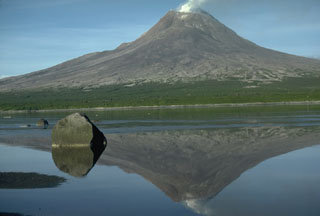Report on Augustine (United States) — January 1976
Natural Science Event Bulletin, vol. 1, no. 4 (January 1976)
Managing Editor: David Squires.
Augustine (United States) Explosive activity on 22 January precedes major eruptions
Please cite this report as:
Global Volcanism Program, 1976. Report on Augustine (United States) (Squires, D., ed.). Natural Science Event Bulletin, 1:4. Smithsonian Institution. https://doi.org/10.5479/si.GVP.NSEB197601-313010
Augustine
United States
59.3626°N, 153.435°W; summit elev. 1218 m
All times are local (unless otherwise noted)
Explosive activity, as measured by University of Alaska Geophysical Institute infrasonic stations, began on the afternoon of 22 January, and at 0745 on 23 January the first major ash eruption occurred. A second major explosion and ashfall followed at 1645 that afternoon. At least five major eruptions took place during the following 3 days. Ash clouds penetrated the tropopause, reaching heights of 14 km as measured by ANR height-finding radars. A light dusting of ash (~1.5 mm) fell at Anchorage. Ash also fell at Iliamna, Homer, and Seldovia, Alaska.
Microearthquake swarms and occasional explosions have been noted on the volcano since mid October. Island seismographs, presumably damaged by premonitory activity, stopped telemetering earthquake data about one week prior to the main eruptions. A strong increase of earthquake activity was recorded, however, on 22 January, on the University of Alaska and USGS seismic stations located on the mainland, W of the island volcano. Intense swarm activity accompanied the main eruptive phase. Lahars, mudflows and pyroclastic flows descended the flanks and some reached the sea. Vent-clearing and subsequent explosions removed much of the 1963-64 dome, resulting in a crater breached to the N.
The Burr Point Research Station (NW tip of the island) was severely damaged by blast and thermal effects from one or more nuées ardentes, and scoria and ashfall. Temperatures greater than 400°C were measured 9 feet below the surface of a pyroclastic flow E of the research station.
Chemical and petrographic analyses of the first 23 January ashfall, sampled at Seldovia and Iliamna, indicates that initial melt accompanying vent breaching explosions was dacitic andesite as documented in the following partial chemical analysis: SiO2 = 63.8%, Fe2O3 = 2.1%, FeO = 2.0%, MgO = 2.1%, CaO = 5.1%, Na2O = 3.9%, K2O = 1.3%. A relatively quiet period extended from 27 January to the end of the month.
Geological Summary. Augustine volcano, rising above Kamishak Bay in the southern Cook Inlet about 290 km SW of Anchorage, is the most active volcano of the eastern Aleutian arc. It consists of a complex of overlapping summit lava domes surrounded by an apron of volcaniclastic debris that descends to the sea on all sides. Few lava flows are exposed; the flanks consist mainly of debris-avalanche and pyroclastic-flow deposits formed by repeated collapse and regrowth of the summit. The latest episode of edifice collapse occurred during Augustine's large 1883 eruption; subsequent dome growth has restored the edifice to a height comparable to that prior to 1883. The oldest dated volcanic rocks on Augustine are more than 40,000 years old. At least 11 large debris avalanches have reached the sea during the past 1,800-2,000 years, and five major pumiceous tephras have been erupted during this interval. Recorded eruptions have typically consisted of explosive activity with emplacement of pumiceous pyroclastic-flow deposits followed by lava dome extrusion with associated block-and-ash flows.
Information Contacts: R. Forbes, Univ. of Alaska; P. Sventek, USAF, Cold Bay.

